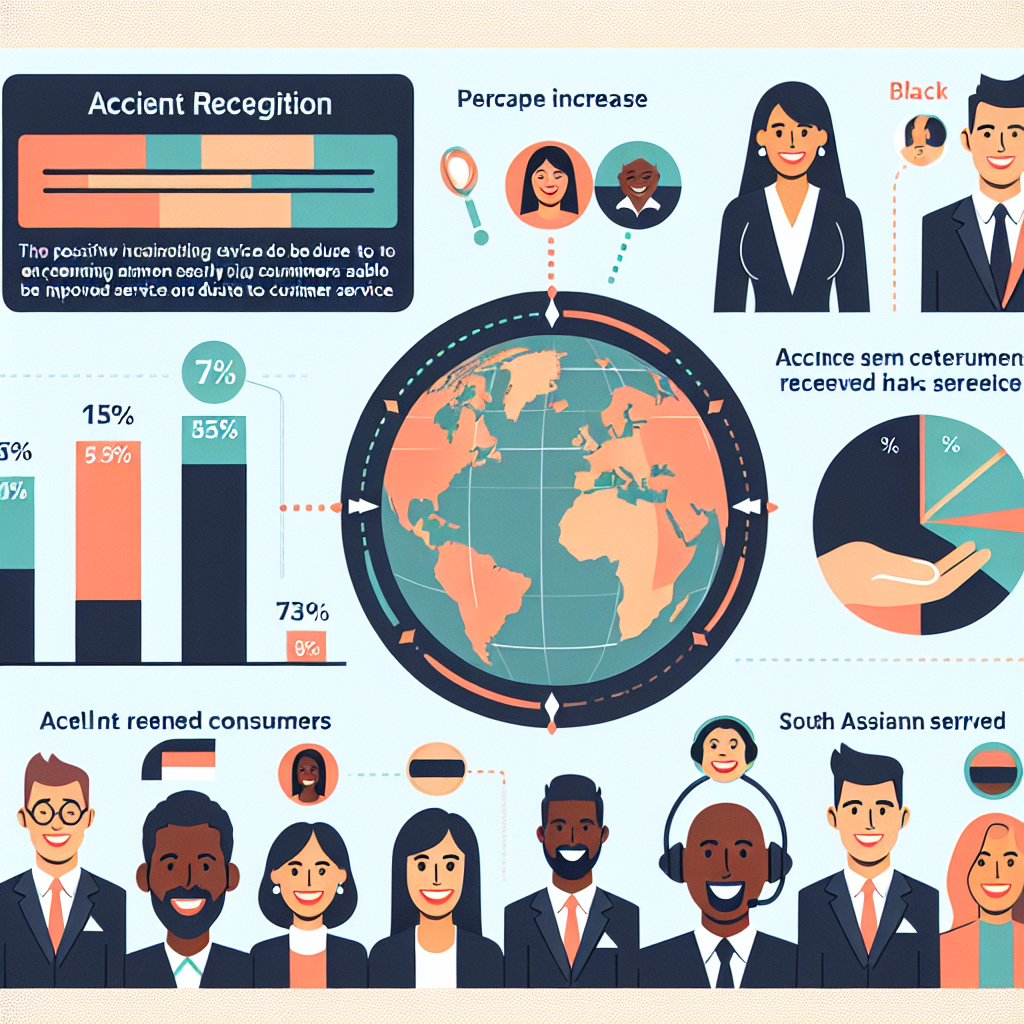
In today's digital landscape, one aspect that is gaining significant focus is the development of understanding regional accents and dialects in automated systems. The technology at the forefront of this development is known as Automated Accent and Dialect Recognition.
Automated Accent and Dialect Recognition uses intricate algorithms to identify specific accents and dialects. Through phonetic analysis, these systems can discern and comprehend the distinct variations in speech. The significant progress made in speech recognition technology has opened doors for the improvement of this ground-breaking feature.

The utilization of Automated Accent and Dialect Recognition has profound implications for various sectors, particularly in upgrading the functionality of AI virtual receptionists. AI can interpret prompts with regional accents and dialects more accurately, thus leading to effective communication and an elevated customer experience. This technology is paving the way for a broader understanding of global dialects and thus, improving overall routing mechanisms.
It is clear that the accurate recognition of accents and dialects plays a vital role in crafting a seamless user journey. By incorporating Automated Accent and Dialect Recognition into systems, AI can now provide service at par with a human receptionist’s understanding and intuition, creating a more connected and inclusive world.
Automated accent and dialect recognition for improved routing predominantly relies on the capabilities of Artificial Intelligence (AI) and Machine Learning (ML). These technologies, coupled with phonetic analysis and language modeling, are paramount for the efficient recognition and differentiation of accents and dialects.
Technically, phonetic analysis and language modeling are core pillars of Natural Language Processing (NLP), a significant subset of AI that is extensively used in dialect and accent recognition. NLP allows machines to comprehend human language by analyzing, interpreting, and generating human text or speech. NLP techniques in their entirety are a series of complex algorithms and procedures, with enormous potential for enhanced communication systems.
Phonetic analysis is particularly crucial in understanding spoken language. It involves breaking down speech into phonemes, which are the smallest units of sound in a language that hold meaning. Deep learning algorithms specially employed in information extraction allow phonetic analysis to occur by training models to recognize phonemic variations in different accents or dialects.
Language modeling, on the other hand, is concerned with predicting the probability of a sequence of words in a specific language. This is often leveraged in text-to-speech and speech-to-text translations, a crucial step towards achieving accent-specific routing in call centers and automated voice response systems.
To improve the accuracy and efficiency of automated accent and dialect recognition, machine learning models are trained on extensive datasets of different accents and dialects. Over time, these models learn to recognize and distinguish between various linguistic nuances, paving the way for improved routing and enhanced communication experiences.
In the fast-paced world of customer service, every moment counts. That's where Automated Accent and Dialect Recognition systems come into play. These advanced solutions have the incredible ability to not only recognize the accent and dialect of a caller but redirect them to service agents best equipped to cater to their specific needs.
This system drastically reduces response time, giving end-users a more streamlined and hassle-free experience. Not to mention, it eradicates chances of miscommunication - a commonly reported issue when agents deal with customers of different dialects and accents. By recognizing these aspects at the outset, the customers immediately connect with agents who are already familiar with their particular communication style, thereby increasing customer satisfaction.

Automated Accent and Dialect Recognition technologies are also beneficial to companies. They help agents work more efficiently, reducing the time spent on clarification, repeat calls, or misunderstanding, thus improving overall productivity.
Moreover, these systems help bridge language barriers that could otherwise strain the customer-agent relationship.
In conclusion, investing in accent and dialect recognition systems is key to enhancing the customer experience by acknowledging and catering to their unique communication styles. It goes a step further in making customers feel seen, heard, and appreciated, thereby instilling trust and loyalty towards the brand.
Implementation of Automated Accent and Dialect Recognition not only benefits customers and companies alike but also paves the way for a more inclusive and understanding customer support landscape.
With the exponential advancement of technology, the development of automated accent and dialect recognition systems is a promising revolution. However, this compelling function presents a variety of challenges that require astute consideration. First and foremost, we grapple with the variability of speech, a factor that's as dynamic as human nature itself.
Human speech is simultaneously intricate and nuanced, encompassing subtleties that are often challenging to capture with technology. Different accents and dialects present unique sound contours, with variations even within the same geographical regions or communities. Emphasizing this, the Proceedings of the National Academy of Sciences (PNAS) points out instances of internal variability, where a single individual's accent varies subtly throughout a conversation based on factors like mood, audience and context.
Privacy is another critical concern. Ensuring that a balance is struck between utilizing speech data for improved services and protecting user privacy is paramount. Companies must adhere to regulations such as the General Data Protection Regulation (GDPR) in the European Union, and the California Consumer Privacy Act (CCPA) in the United States. Additional guidance can also be gleaned from NIST Privacy Framework.
The ethical considerations of implementing automated accent and dialect recognition are not to be overlooked. It is crucial to avoid unintentional discrimination or bias in these technologies. Inclusivity and fairness should be at the forefront, ensuring everyone, regardless of their accent or dialect, can use and benefit from these automated systems.
Thus, while automated accent and dialect recognition can revolutionize routing and personalization in numerous sectors, it is crucial to navigate these challenges carefully, maintaining a focus on user privacy, inclusivity, and sensitivity to the intrinsic variability in human speech.
Accent and dialect recognition technology has proven to be a cutting-edge solution for businesses looking to enhance their service delivery processes. A growing number of companies are integrating automated systems to streamline their operations and improve customer service interactions. To better understand the practical application and tangible benefits of this technology, we'll examine two case studies where accent recognition has been successfully implemented.

The first case comes from CallMiner, a company specializing in conversation analytics. With a focus on accent recognition, CallMiner assisted a major telecom provider to efficiently route calls to agents who were fluent in the customer's native dialect. The system analyzed the client's voice in real-time, identifying the accent and instantly routing the call to an appropriate agent. With this technology, the telecom provider reported an increase in call efficiency, a decrease in miscommunication errors, and overall improved customer satisfaction.
Our second showcase highlights Uniphore’s U-Analyze platform. Uniphore incorporated accent recognition capabilities in their customer service system that was designed for a multinational bank. The bank hosts a diverse customer base, and accent variation significantly impacted their customer interaction. The U-Analyze tool analyzed the customer’s voice during interaction and tailors responses based on their dialect. This led to improved communication, personalized customer interaction, and an increase in customer trust and satisfaction.
These examples underscore the substantial value that automated accent and dialect recognition can bring to businesses. From improved call routing to enhanced communication and customer service experiences, the technology has proven successful in both service efficiency and overall customer satisfaction. As the shift towards more personalized customer service continues, accent recognition technology is set to play a crucial role.
With the tremendous advancements in artificial intelligence and machine learning, we're stepping into an era of remarkable growth in a hitherto less-explored arena - Automated Accent and Dialect Recognition. Primarily used for improving routing in customer service industries, this technology promises fascinating future prospects.
The concept of automated accent and dialect recognition encompasses complex algorithms that identify and analyze linguistic patterns to enhance voice recognition features. An accurate accent and dialect recognition directly impacts routing efficiency, aiming to connect callers with customer care representatives best suited to understand their accents.
The potential of accent recognition technology doesn't just stop at customer care improvements. Numerous possibilities lie in its ability to advance fields like linguistics, cross-cultural communications, cybersecurity, and even entertainment. The technology could amplify language preservation efforts by identifying and transcribing endangered languages, thereby significantly contributing to our understanding of cultural diversity.
For businesses with global outreach, accent recognition could influence strategies for targeted marketing. For instance, understanding regional linguistics nuances enables personalized advertisements, boosting customer engagement. The technology could also be implemented in security measures, aiding in voice biometric authentication.
Moreover, in the realm of entertainment, this technology could revolutionize foreign film industries. Automatic dialect recognition might streamline dubbing and subtitling processes, enhancing viewers' experiences and expanding cultural boundaries.
Although, the development of a perfect accent detection system faces considerable challenges due to inherent linguistic diversity and constant changes in spoken languages. Nevertheless, with ongoing research and development efforts, it isn't hard to foresee a future where Automated Accent and Dialect Recognition becomes a standard tool in global communication strategies.
Start your free trial for My AI Front Desk today, it takes minutes to setup!








